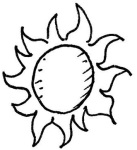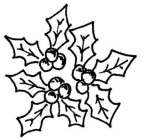Today is the summer solstice, the longest day of the year and the shortest night, and the moment that the sun halts its journey southward and stands still, before turning back and heading towards the north. (Of course it’s not really the sun doing the moving, it’s us and our position relative to the sun, but that’s how it appears to us because of our belief that everything revolves around us ) It’s a time of magic and enchantment, of late sunsets, blue skies, and immense potential and promise…
Of course in the northern hemisphere it is Yule, the winter solstice, a time of new beginnings and new light…
Adding to the magic of the seasonal wheel, it’s also a new moon today, which brings new energy and inspiration – it’s the perfect time to start thinking about what you want to achieve in the coming month, and the coming year…
Wishing you much love and happiness on this enchanted day, and a wonderful festive season, however you celebrate it!
 In the southern hemisphere today is Litha, the summer solstice. It’s the longest day of the year, and the shortest night, and a time of energy, reawakening, passion and hope. It’s a time to celebrate all you have achieved, to soak up the fruits of your labours and bask in the abundance of your life and the joy you find in your friends and family. That’s why so many pagans still celebrate the traditional idea of Christmas at this time of year, in addition to their Litha rituals. It’s a time to be close to loved ones, to feast and celebrate and honour your own wisdom and how far you have come in the past year, to celebrate power, joy, and the courage to walk boldly into the new year. It’s a bountiful, abundant, fertile time, a time of flowers and ripeness and heat. Breathe in the scent of red, gold and orange blooms, of herbs like chamomile, honeysuckle, lavender, yarrow, thyme and elder, light an oil burner with inspiring, activating, energising oils like orange, lemon, rosemary and jasmine. Breathe in the power of the sunshine, the warmth of the land, the energy of the universe that you can attune yourself to in order to motivate you to move forward. Litha also brings the magical, mystical, enchanted Midsummer Night’s Eve, the famous time of fairies and fun and mischievous sprites who dance through the air, and through your heart, and encourage you to enjoy the beauty of the world, and the magic of your life.
In the southern hemisphere today is Litha, the summer solstice. It’s the longest day of the year, and the shortest night, and a time of energy, reawakening, passion and hope. It’s a time to celebrate all you have achieved, to soak up the fruits of your labours and bask in the abundance of your life and the joy you find in your friends and family. That’s why so many pagans still celebrate the traditional idea of Christmas at this time of year, in addition to their Litha rituals. It’s a time to be close to loved ones, to feast and celebrate and honour your own wisdom and how far you have come in the past year, to celebrate power, joy, and the courage to walk boldly into the new year. It’s a bountiful, abundant, fertile time, a time of flowers and ripeness and heat. Breathe in the scent of red, gold and orange blooms, of herbs like chamomile, honeysuckle, lavender, yarrow, thyme and elder, light an oil burner with inspiring, activating, energising oils like orange, lemon, rosemary and jasmine. Breathe in the power of the sunshine, the warmth of the land, the energy of the universe that you can attune yourself to in order to motivate you to move forward. Litha also brings the magical, mystical, enchanted Midsummer Night’s Eve, the famous time of fairies and fun and mischievous sprites who dance through the air, and through your heart, and encourage you to enjoy the beauty of the world, and the magic of your life.
 In the northern hemisphere however today is Yule, the winter solstice, the day of magic that celebrates the rebirth of the sun, and which the traditions of Christmas are all based on. Pagans in the northern hemisphere celebrated the winter solstice – the longest night of the year, and the shortest day, which indicated the return of the sun – for centuries before the coming of Christ. For them it was symbolic of the goddess giving birth to the god, of the turning of the wheel of life from the barrenness and death in the fields to the rebirth promised by the lengthening of the days. It was the time of the great feast, when the last of the winter’s stores would be used up, knowing the sun was on its way back to bring new life, and of gift giving and celebration.
In the northern hemisphere however today is Yule, the winter solstice, the day of magic that celebrates the rebirth of the sun, and which the traditions of Christmas are all based on. Pagans in the northern hemisphere celebrated the winter solstice – the longest night of the year, and the shortest day, which indicated the return of the sun – for centuries before the coming of Christ. For them it was symbolic of the goddess giving birth to the god, of the turning of the wheel of life from the barrenness and death in the fields to the rebirth promised by the lengthening of the days. It was the time of the great feast, when the last of the winter’s stores would be used up, knowing the sun was on its way back to bring new life, and of gift giving and celebration.
On the same day, the ancient Egyptians celebrated the birth of the son of the goddess Isis, the Arabs the birth of the moon, and the Romans the winter festival of Saturnalia, focused on Saturn, the god of the harvest. Feasting, celebration, partying and gift giving were common to all of them.
(For the first three hundred years AD, there was no festivity of the birth of Jesus, and from the biblical description it’s highly unlikely he was born in December. But in 350AD, Pope Julius I declared that Christ’s birth would be celebrated on December 25, to make it as painless as possible for pagan Romans to convert to Christianity. The new religion went down a bit easier, knowing their festivals would not be taken away from them. At the end of the fourth century the Bishop of Constantinople wrote: “On this day the Birthday of Christ was lately fixed at Rome in order that while the heathen were busy with their profane ceremonies, the Christians might perform their sacred rites undisturbed. They call this the Birthday of the Invincible One (Mithras); but who is so invincible as the Lord?”)
Some of the pagan traditions of modern Christmas
The tree: Live evergreen trees were brought into homes during the harsh winters as a reminder that their crops would soon grow again. Evergreen boughs were carried as totems of good luck and were present at weddings, representing fertility. The druids used the tree as a religious symbol, holding their sacred ceremonies around them. Trees were first decorated for Christmas in Germany, with candies, fruit and paper roses.
The Yule log: Magic, with its tenent of “As above, so below,” meant pagans believed that to have a blazing fire on earth would encourage the sun to grow stronger. The winter solstice is a fire festival, with bonfires being lit to help the sun grow stronger. The Yule log also served a more practical purpose of warming the home during a cold night in which many people stayed awake for longer than usual. The word Yule means wheel, the wheel being a pagan symbol for the sun. Armenians make a wish on the Yule log when it’s ignited and sometimes make divinations by the cinder patterns left over.
Mistletoe: This is an old pagan symbol of regeneration and eternal life, and is associated with healing. Mistletoe was considered a sacred plant by the druids, and the custom of kissing under the mistletoe began as a fertility ritual. The Romans valued it as a symbol of peace, which led to its use as one of the common symbols of Christmas. In Scandinavia, it is associated with Frigga, their goddess of love.
Holly: Pagans placed holly leaves around homes in winter to provide shelter for fairies, and holly berries were thought to be a food of the gods. In ancient Rome holly was associated with Saturn, the god of the harvest. Early Christians probably adopted this tradition to avoid persecution. It was later reinterpreted with Christian symbolism – the pointy edges are said to represent the crown of thorns and the red berries Christ’s blood.
Candles: For pagans, it was customary to light a candle to encourage the sun god, and the sun, to reappear next year. Candles are also for protection. Later, in Victorian times, candles were placed in windows of homes to let the poor know there was shelter available for them there.
Christmas carols: People used to dance and sing to celebrate the shortest day of the year, and this evolved into the singing of Christmas carols. In ancient Rome, their winter holiday Saturnalia was marked by much merrymaking. It is there that the tradition of the Mummers was born, groups of costumed singers and dancers who travelled from house to house entertaining their neighbors. From this, the Christmas tradition of caroling was born.


Get Social